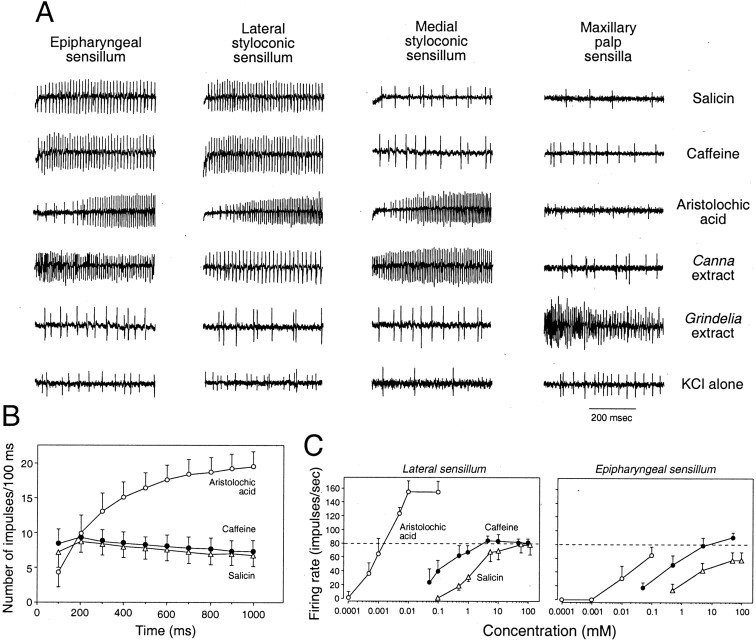Fig. 2.
Illustration of how the peripheral taste system ofM. sexta mediates the aversive response to the five “bitter” taste stimuli used in this study. A, Excitatory responses of the four different classes of taste sensilla to five bitter taste stimuli (10 mm salicin, 5 mmcaffeine, 0.1 mm aristolochic acid, 0.3×Canna extract, and 1× Grindelia extract; see Materials and Methods for additional details). These neural responses are typical of habituated and nonhabituated caterpillars (Glendinning et al., 1998, 1999, 2001a; J. Glendinning, unpublished data). The onset of stimulation occurred at the beginning of each trace, and each vertical line reflects the occurrence of an action potential. In most of the traces containing a large number of action potentials, there is a single taste cell (the bitter-sensitive taste cell) firing regularly and another taste cell (the salt-sensitive taste cell) firing sporadically. The only exception is the multiunit response of the maxillary palp sensilla to theGrindelia extract, which probably contains action potentials from several bitter-sensitive taste cells. Because all bitter taste stimuli were presented in a 0.1 m KCl solution, we also show representative responses of each sensillum to the electrolyte solution alone for comparison (see bottom row of traces). Note that each bitter taste stimulus selectively activates bitter-sensitive taste cells in a subset of the taste sensilla (e.g., the Grindelia extract stimulated bitter-sensitive taste cells only in the maxillary palp). Furthermore, note that the only taste sensilla that are sufficient to mediate an aversive response to a particular bitter taste stimulus (Table 1) are the ones that contain a bitter-sensitive taste cell that responds vigorously to the same bitter taste stimulus.B, Instantaneous firing rates (total impulses/100 msec; median ± median absolute deviation) of the bitter-sensitive taste cell in the lateral styloconic sensillum to 5 mm caffeine, 10 mm salicin, and 0.1 mm aristolochic acid across 1000 msec of stimulation (Glendinning and Hills, 1997). It is revealed in B (and shown in the traces inA) that caffeine and salicin elicit a relatively tonic pattern of spiking, whereas aristolochic acid elicits an accelerating pattern of spiking. C, Excitatory responses (impulses per second; median ± median absolute deviation) of the bitter-sensitive taste cell in the lateral styloconic and epipharyngeal sensilla to a range of aristolochic acid, caffeine, and salicin concentrations (Glendinning et al., 1999). Note that aristolochic acid elicits a maximal firing rate in the lateral styloconic sensillum that is twice that elicited by caffeine and salicin; no such difference is apparent in the epipharyngeal sensillum.

